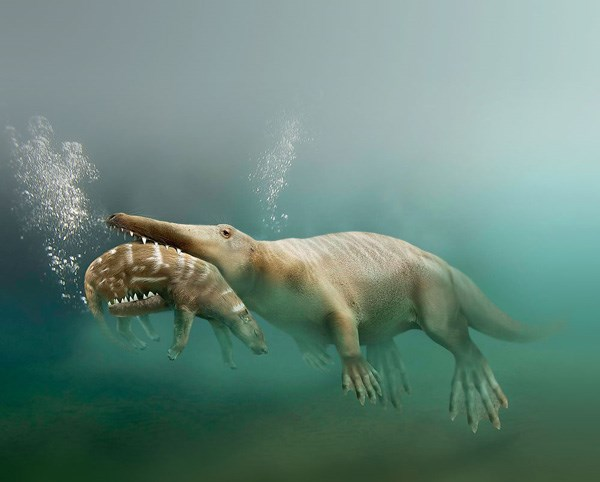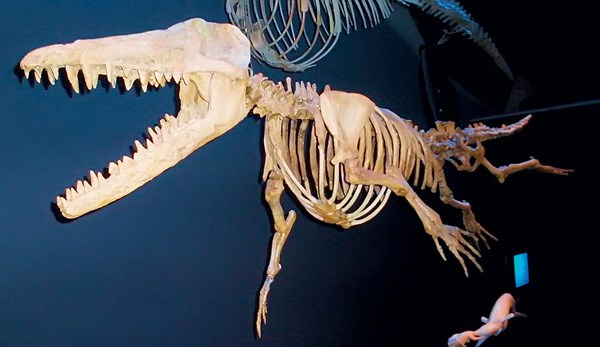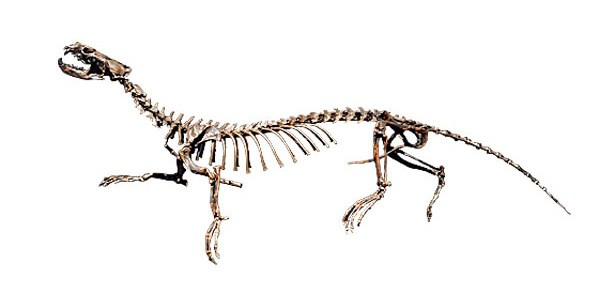Ancient link to whale origins : Why do species leave the land back to the sea?

Found in Pakistan "walking whale floating" (Ambulocetus natans) in the artist's view
Life came to the dry land out of the water, but sometimes something draws her back. Marine mammals - whales, seals, dugongs - grew fins or fins, changed the shape of the body and adapted to a long or even permanent stay in the aquatic environment. But after all, they once had land ancestors. What did they look like? How did you start the transition to an aquatic lifestyle?
For a long time the answer to these questions was science is not clear, and between the world of aquatic mammals and the land world of their ancestors, there was something like a missing link. However, paleontological findings of recent times have brought a certain clarity in the subject. So who from mammals lives in the ocean? Let's start with the most exotic - sirens. In 1741, during a sad for the Danish-Russian navigator Vitus Bering of the Second Kamchatka expedition, a very large sea animal was discovered near the Commander Islands. Possessing a spindle-shaped body (which terminated a forked tail, similar to a whale's tail), it reached a weight of 5 tons and had up to 8 meters in length. The German animal scientist Georg Steller described the animal participant of the expedition, and the creature, unprecedented before, began to be called a stalker cow. But why the cow? Not only because of the size.
Elephants and their underwater cousins
The giant animal was herbivorous. Like a real cow, it grazed and plucked grass, or rather, sea kale in shallow water. Such a large and harmless animal after its discovery by people, of course, could no longer count on a long life. By 1768, "cabbage" was knocked out, and now you can see the stalker cow only in the form of a skeleton or a picture. But the unfortunate inhabitant of the Bering Sea has a close family in the world. Stellerova cow on zoological classification refers to the family of Dugongs, which includes the still living on the planet dugongs, and further to the group of sirens, which also include manatees.
All sirens are herbivorous (unlike whales or seals), but they live exclusively in shallow water and can not, like whales, go into the ocean depths or, like seals, get out on land. With whales, the sirens are related to the absence of hind limbs. But once these limbs were.
In 1990, in Jamaica, American paleontologist Daryl Domning discovered in the coastal sediments a great location with the petrified remains of marine vertebrates, as well as land animals like a primitive rhinoceros. In the same place, an almost complete skeleton of a creature living in the Eocene (about 50 million years ago) and previously unknown to science was found. The find was called Pezosiren portelli. This very "Pesoziren" had a heavy skeleton, very similar to the skeletons of the current sirens. Powerful heavy ribs are needed by the sirens to give the body a negative buoyancy, and, apparently, the same task faced the ancient animals, which indicates a semi-aquatic lifestyle. On the other hand, Pesotiren clearly could move by land, he had all four limbs and no tail and fins. In short, this animal, apparently, in the way of life was similar to a hippopotamus, which is also indicated by the nostrils turned upwards. But who among the living creatures is considered the closest relative of the sirens? It turns out that they are not hippos at all.
Sirens are included in the order of placental mammals "afrotheria", that is, "African animals." This branch, which originated from Africa, consists of several detachments, and the closest relatives of sirens are damans - rodent-like small animals the size of a domestic cat. Another closely related to the sirens and damans are the squad trotters, which today are represented exclusively by elephants.
Bears of bears
Sirens are the only major taxon of marine mammals with herbivorous ancestors. Pinnipeds - walruses, eared seals, real seals - descended from predators, also originally landed. However, many researchers tend to consider the concept of "pinnipeds" obsolete, since, according to the widely held opinion in science, pinnipeds are not a mono- but a polyphyletic group, that is, they originate not from one but from different branches of land animals. Nevertheless, pinnipeds undoubtedly belong to the detachment of Carnivora - predatory placental mammals. This detachment is divided into two suborders - pspos and cats. Psposnye - it's bears, martens, raccoons, of course, wolves and dogs, and to cats are cats, viverre, mongooses, hyenas. Without going into the subtleties of classification, it can be said that pinnipeds are part of the psaltery. But here what? Proponents of the polyphyletic origin of the pinnipeds consider that two lines led from the land to the sea. Walrus and eared seals (superfamily Otarioidea) are closely related to the bear, while the true seals (Phocoidea) lead their genus from the Cunites. Similarity in the structure of pinnipeds in this case is due to convergent evolution.
The problem of the "missing link" existed here, too, until in 2007, in the Polar Canada on the island of Devon, an expedition of paleontologist Natalya Rybchinsky found the fossilized remains of an animal named "pujila" (Pujila). Puyila lived in the Miocene, about 24 million years ago, probably in the area of the lake that existed at that time, surrounded by forest. The find was made by accident - a cross-country vehicle broke down, and paleontologists stumbled upon a fossil, wandering around. Puyila was the owner of an elongated body 110 mm long and was able to perfectly move overland on four legs. It looked like a representative of cuns, but the structure of the skull was already similar to that of the head of real seals. In addition, it was assumed that between the toes of the pujil had pads, which indicated a semi-aquatic lifestyle of the beast, associated with frequent movements along the water.
Prior to the discovery of Puilya, the most ancient of the known pinnipeds was the "Marine Bear" who lived in the Miocene. This animal was already very well adapted to a prolonged stay in the water, although it could also be hunted on land. The final swim using all four limbs and had a special inner ear to perceive sound vibrations in the underwater environment. Some features of the structure bring together the artarch with sea lions, that is, with a subfamily of eared seals. Thus, the "sea bear" could be a link in the evolutionary chain, leading from a common ancestor to bear, to walruses and eared seals.

Ambulocet, "The walking whale floating" (Ambulocetus natans). Lived 48 million years ago and was not a whale in the modern sense, but an animal similar in lifestyle to the crocodile.

Pezosiren portelli. An animal that lived 50 million years ago, where today the island of Jamaica, had a body and skull structure, close to manatees and dugongs. The main difference is in the presence of four limbs and the ability to move overland

Puyila (Puijila darwini). The extinct predatory mammal of the suborder is aphid, living in the arctic regions of Canada 21-24 million years ago. This animal is considered to be a transition link from kuni to real seals.
Hoofed Nightmare
So, pinnipeds have descended from predatory placental mammals and are, apparently, close relatives of bears and martens. The third largest taxa of marine mammals - Cetacea - the cetaceans probably also originated from predators. But ... ungulates.
Yes, quite right, there are no such ones in our day, but millions of years ago very scary specimens ran on their hoofs. The largest known terrestrial carnivorous mammal that ever lived on Earth is the Andrewsarch. Found only his skull (in 1923), but the size of the fossil is amazing - 83 cm in length and 56 cm in width. Most likely, Andrewsarkh resembled a giant wolf, and not a real forest inhabitant, and such as the wolves are portrayed in cartoons. The giant was identified in a detachment of mesonichias, whose representatives lived 45-35 million years ago, and then died out. Mesonihia were primitive ungulates with five- or four-fingered limbs, and each finger ended with a small claw. The enormous elongated skull of the Andrewsarkh and the structure of the teeth led paleontologists to the idea of a close relationship with the whales, and back in the 1960s, it was suggested that mesonichia were the immediate ancestors of cetaceans, and the latter, therefore, could be considered close relatives of artiodactyls.
However, molecular genetic studies of later time have led many researchers to conclude that cetaceans are not related to artiodactyls, but in fact they are, developed from their environment. Thus appeared the term cytoparticulate, denoting a monophyletic - ascending to a single ancestor - group, which includes both cetaceans and artiodactyls. Within this group, the nearest relatives of the whales were hippopotami. However, this does not mean that the ancestors of the whales looked like hippos (although such a theory existed).
Seven attempts to go to sea
Leaving land in the sea - under the pressure of natural enemies or in search of food - is not so rare in the history of life on Earth. Reptiles and birds passed to the aquatic and semi-aquatic life. Among the mammals, seven such episodes are known. In addition to the sirens, pinnipeds and cetaceans mentioned in the article, one can recall the polar bear, who, being a close relative of the brown bear, perfectly mastered the marine environment, although the organism did not undergo serious morphological changes. The same can be said of the sea otter, or sea otter, representing the family of cunies. It is difficult to imagine floating sloths, but there were such. The genus of thalassuncles lived in South America in the Miocene - these animals were herbivorous and fed on the vegetation of shallow water. Finally, about 30-8 million years ago, demostilises lived on the shores of the Pacific Ocean - another detachment of marine mammals. Their limbs allowed them to walk on land, but in the water they, apparently, moved more confidently. Dmotolii - relatives of sirens and proboscis.
The problem of the "missing link" between ungulates and cetaceans due to the paucity of the paleontological chronicle has not found its final solution and continues to cause discussion, but a number of finds of recent decades provide convincing clues. If the genesis of pinnipeds took place somewhere in the arctic regions of the planet, the cetaceans owed their origin to the ancient Tethys ocean - the ever-changing water space between the northern continent of Laurasia (the future North America and Eurasia) and Gondwana (South America, Africa, Hindustan, Antarctica and Australia). In the Eocene epoch (56-34 million years ago) under water there were vast territories in the Near and Middle East, on the place of which now mountainous land. In the conditions of warm coastal shallow water, in which there was plenty of fish, some group of ancient ungulates reoriented to the search for food in the sea.
In 1981, a skull was found in Pakistan, which was called Pakiketus. Outwardly with modern whales, he had little in common, the size was with a dog, and looked like a representative of the dog. However, this predator was hoofed. Originally it was recorded in the mesonichia, but later, at the beginning of the new millennium, when the paleontologists finally got a complete skeleton of the pakytset, the animal was identified as a cloven-hoofed, which separated from the mesonichia much earlier. The pakiket had an auditory bulla - a characteristic bone formation for the cetaceans on the skull, which helps to perceive sounds under the water. And although the "Pakistani whale" obviously felt great on land, it often happened in the water and the corresponding evolutionary adaptations have already begun. The auditory bull was also found in another fossil land animal, the Indochius, a tiny artiodactyl, whose remains were discovered in India. Indochius could be even not a predator at all, but an innocuous herbivore, who climbed into the water, escaping from natural enemies, for example from birds of prey. And in 1992 in Pakistan found the fossilized bones of the ambulocet, Ambulocetus natans - the "walking whale floating".
With a large morphological similarity with the cetaceans, the ambulocete could still move overland, lead a semi-aquatic life and was a crocodile-type predator. It took millions of years of evolution to move the whales to a completely aquatic life, and then left the coastal waters to the depths of the ocean. Pakacet, Indochius, ambulocet - they all lived in the Eocene 50-48 million years ago. Because there is no genetic material in the fossils, it is impossible to say through which of these creatures a straight line leads to modern cetaceans, but the general mechanism for the conversion of artiodactyls into whales, dolphins and sea porpoises has become generally clearer.

References for Text and Images:
- http://stories.anmm.gov.au/whale-evolution/
- https://en.wikipedia.org/wiki/Ambulocetus
- http://carnivoraforum.com/topic/9344640/1/
- http://rushelle.com/gallery/the-evolution-of-toothed-whales-(skeletal-study)
- http://kristopherbernard.blogspot.in/2014/05/the-whale-that-walked.html
Support @steemstem and the #steemstem
project - curating and supporting quality STEM
related content on Steemit

You have collected your daily Power Up! This post received an upvote worth of 1.9$.

Learn how to Power Up Smart here!